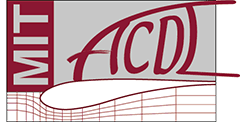"Advanced Calibration and Navigation Algorithms for Airborne Magnetic Anomaly Navigation" by Albert Gnadt
ABSTRACT: This talk will provide an overview on airborne magnetic navigation with an emphasis on the challenges and possible solutions for real-world implementation on an operational aircraft. An airborne magnetic navigation system collects real-time magnetic field data and uses predetermined magnetic maps of the earth to estimate location by aiding an inertial navigation system (INS), which would otherwise drift. The central outstanding issue is handling corruption of the measured magnetic signal by the aircraft itself. Multiple approaches to enable high-accuracy magnetic navigation, despite receiving heavily corrupted magnetic field measurements, will be introduced.
BIO: Albert Gnadt is a PhD student working with Alan Edelman and Chris Rackauckas in the Julia Lab within CSAIL. His current research is focused on improving airborne magnetic navigation using machine learning approaches, and previously he worked on electric aircraft design. Outside of work he enjoys being active, including skiing, rollerblading, and sailing. Albert earned his private pilot license during the summer of 2020 when the skies were conveniently more empty than normal.
-------------------------------------------------------------------------------------
"Hierarchical Low-Rank Conditional Structure in Transport Maps for Bayesian Inverse Problems" by Michael Brennan
ABSTRACT: We will present a methodology for building structured transport maps for Bayesian inverse problems. In general, Bayesian inference requires the evaluation of integrals with respect to some target distribution whose density is only known up to a normalizing constant. One approach that has recently gained popularity, as both an alternative and a complement to standard sampling strategies such as MCMC, is to form a deterministic mapping---a transport map---between the posterior and a simple reference density that can be easily sampled, e.g., a standard Gaussian.
The success of transport map-based methods depends on our ability to optimize the parameters of a transport map, and high-dimensional inference problems can lead to computationally burdensome optimization problems. We introduce a technique for building transport maps with a particular type of low-dimension structure, hierarchical low-rank conditional structure, that reduces the number of map parameters that need to be optimized while still accurately capturing the posterior. We will show examples where our hierarchically structured maps achieve similar inference accuracy to un-structured baselines with fewer map parameters.
BIO: I am a PhD student in Computational Science and Engineering advised by Prof. Youssef Marzouk of the MIT Uncertainty Quantification Group. My research is broadly in numerical methods for uncertainty quantification and probabilistic machine learning. I am currently interested in techniques that can uncover and exploit structure in statistical inference problems. Before joining MIT, I received an M.S. in Mathematics from Virginia Tech, where I studied nonlinear eigenvalue problems and reduced order modeling.

